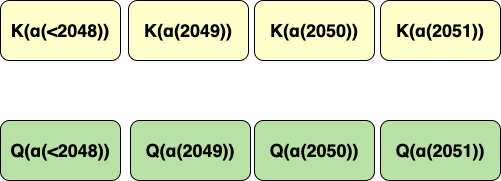Weeks ago, u/emozilla proposed an improvement on NTK-Aware RoPR in this post, later named DynamicNTKScalingRotaryEmbedding. The main idea behind Dynamic NTK involves incorporating a scaling factor relative to the present decoding sequence length to improve the base functionality. However, there is actually a subtle gap between how we compute perplexity and how the LLM actually generates tokens.
If you are using the DynamicNTKRope implemented by Huggingface, the sequence length remains fixed when calculating perplexity, and no key cache is needed. As a result, there are no rotation base inconsistency between keys.
However, when LLM starts generation token by token beyond its maximum trained length, the sequence length increases and each key is continually pushed into the key-value cache. Consequently, we have such a rotation inconsistency between keys.
To put it clearly, while LLM decoding, the current DynamicNTKRope is implemented as
From my understanding, we should keep the rotation base consistent, which is:
When decoding sequence length = seq2
As decoding sequence length increases to seq3,
Please check this blog for more details.
from transformers import AutoTokenizer, LlamaForCausalLM
import torch
from scale_rope.consistent_rope_for_llama_patch import replace_llama_attn_with_consistent_ntk_rope
model = LlamaForCausalLM.from_pretrained(PATH_TO_CONVERTED_WEIGHTS)
tokenizer = AutoTokenizer.from_pretrained(PATH_TO_CONVERTED_TOKENIZER)
prompt = "Hey, are you conscious? Can you talk to me?"
inputs = tokenizer(prompt, return_tensors="pt")
replace_llama_attn_with_consistent_ntk_rope()
# Generate
generate_ids = model.generate(inputs.input_ids, max_length=30)
tokenizer.batch_decode(generate_ids, skip_special_tokens=True, clean_up_tokenization_spaces=False)[0]A patch, replace_llama_attn_with_inconsistent_ntk_rope_for_ppl is applied to bridge the gap between perplexity evaluation and decoding. You can find it in the directory scale_rope/inconsistent_rope_for_perplexity. Please set inconsistent_dntk as True in eval_ppl.py, to enable the patch.
The inconsistent_ntk patch changes the rotary computation on Key and Query as below:
We can see from the figure below that when keeping the rotation base between keys inconsistent w.r.t context length, the perplexity significantly increases, indicating DynamicNTK harms the performances. This finding might initially seem counterintuitive.
However, as the sequence length continues to grow, we can notice a gradual reduction in perplexity for inconsistent Dynamic NTKScale RoPE . Interestingly, the inconsistent Dynamic NTKScale RoPE outperforms the NTKScale RoPE in terms of perplexity when the sequence length exceeds 5,000.
 Figure1, Perplexity value on Llama1-7B, an 2k max sequence length model, values above 12.0 are cut off for concise; Vanilla: RoPE w/o any interpolation; NTK: DynamicNTK when scale=1; Consistent DynamicNTK: keep rotation base between keys consistent, current huggingface implementations; Inconsistent DynamicNTK: keep rotation base between keys inconsistent w.r.t context length;
Figure1, Perplexity value on Llama1-7B, an 2k max sequence length model, values above 12.0 are cut off for concise; Vanilla: RoPE w/o any interpolation; NTK: DynamicNTK when scale=1; Consistent DynamicNTK: keep rotation base between keys consistent, current huggingface implementations; Inconsistent DynamicNTK: keep rotation base between keys inconsistent w.r.t context length;
Table 1: PPL Value of Different NTKScale Methods
| Lenth | Consistent Dynamic NTKScale PPL | Inconsistent Dynamic NTKScale PPL | NTKScale PPL |
|---|---|---|---|
| 2800 | 4.285102386474609 | 10.203343925476075 | 4.301338438987732 |
| 3600 | 4.371902356147766 | 9.213108296394347 | 5.401671919822693 |
| 5600 | 4.536222472190857 | 8.04413757801056 | 10.291163015365601 |
| 7200 | 4.7303602981567385 | 7.674421100616455 | 15.359781618118285 |
| 8000 | 4.932255864143372 | 7.7100021314620975 | 15.884212293624877 |



